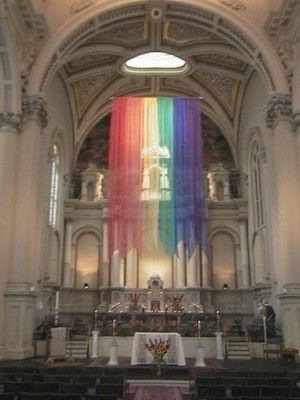New York Times scoop! Catholic same-sex unions!
 Talk about burying the lede. The mainstream press has been on a tear ever since President Barack Obama announced that his liberal Christian faith had inspired him to change his beliefs on the definition of marriage. One of the most common stories, produced by news outlet after news outlet, has focused on the ways that this doctrinal issue has divided various groups of believers.
Talk about burying the lede. The mainstream press has been on a tear ever since President Barack Obama announced that his liberal Christian faith had inspired him to change his beliefs on the definition of marriage. One of the most common stories, produced by news outlet after news outlet, has focused on the ways that this doctrinal issue has divided various groups of believers.
This is a totally valid story to be covering, since believers on both sides of this issue are separated by centuries of doctrine and tradition. Here are the pivotal paragraphs in a typical New York Times report. However, when reading this passage, prepare yourself for the stealth blockbuster:
Mr. Obama’s declaration last week that he supports same-sex marriage prompted ministers around the country to take to their pulpits on Sunday and preach on the issue. But in the clash over homosexuality, the battle lines do not simply pit ministers against secular advocates for gay rights. Religion is on both sides in this conflict. The battle is actually church versus church, minister versus minister, and Scripture versus Scripture.
The dividing lines are often unpredictable. There are black churches that welcome openly gay couples, and white churches that do not. Some Presbyterian churches hire openly gay clergy members, while others will not. The Roman Catholic Church teaches that homosexual behavior is a sin, but there are Catholic priests who secretly bless gay unions.
Did you catch that last reference? If, in fact, the Times has factual material about Catholic priests blessing same-sex relationships and unions then this is clearly the most important news angle in this piece. This is a major news story, buried deep in a related news report.
However, note that this claim (which I do not doubt, by the way) appears with absolutely no context, no attribution, no clue as to the source of this information. The Times does not even claim to be printing this information based on anonymous sources who requested protection from the Vatican. This is most strange.
I don't know about you, but this passage immediately made me think of the following quotation:
Readers of The New York Times demand to know as much as possible about where we obtain our information and why it merits their trust. For that reason, we have long observed the principle of identifying our sources by name and title or, when that is not possible, explaining why we consider them authoritative, why they are speaking to us and why they have demanded confidentiality. Guidance on limiting the use of unidentified sources, and on informative description of those we do use, has appeared in several editions of our stylebook, including the current one, and in our Integrity Statement, dating from 1999.
This is, of course, the top of a report on The New York Times Company's policy on the use of confidential sources. The key is that, when editors approve the use of a confidential source, reporters are still supposed to provide readers with as much information as possible in order to explain why they should trust this news story.
But wait, since we are dealing with a story that is about religion, linked to a "social values" issue on which all urbane, intelligent citizens would be in agreement, this may be one of those cases in which -- under the Bill Keller revelation -- that the Times no longer needs to play by conventional journalism rules about bias and fairness. That's the ticket.
You remember the Keller doctrine, right? Here's a reminder, with the recently retired editor discussing (video source here) whether his newspaper now openly plays an advocacy role on behalf of liberal policies and beliefs:
“We are liberal in the sense that we are open-minded, sort of tolerant, urban. Our wedding page includes -- and did even before New York had a gay marriage law -- included gay unions. So we’re liberal in that sense of the word, I guess. Socially liberal.”
Asked directly if the Times slants its coverage to favor “Democrats and liberals,” he added: “Aside from the liberal values, sort of social values thing that I talked about, no, I don’t think that it does.”
Now, there are other passages in this recent Times story that merit discussion. For example, pro-gay rights scholars compare scriptural references to sexuality with those describing slavery, yet the story offers no material describing traditional Jewish, Catholic, Eastern Orthodox or Protestant viewpoints on that issue.
You know, the usual stuff. Once again, however, one must ask it -- post Keller confession -- the leaders of the Times believe they have any responsibility to accurately report the views of those who dissent from the newspaper's approved religious doctrines.
Still, this story does appear to include a major innovation, one that appears to violate the newspaper's policies. So let me ask: "What is the source of the information reflected in the following statement? I refer to this sentence: 'The Roman Catholic Church teaches that homosexual behavior is a sin, but there are Catholic priests who secretly bless gay unions.' "
Is this statement based on anonymous sources? If so, how can they best be described, so that readers have a chance to evaluate the validity of this claim?